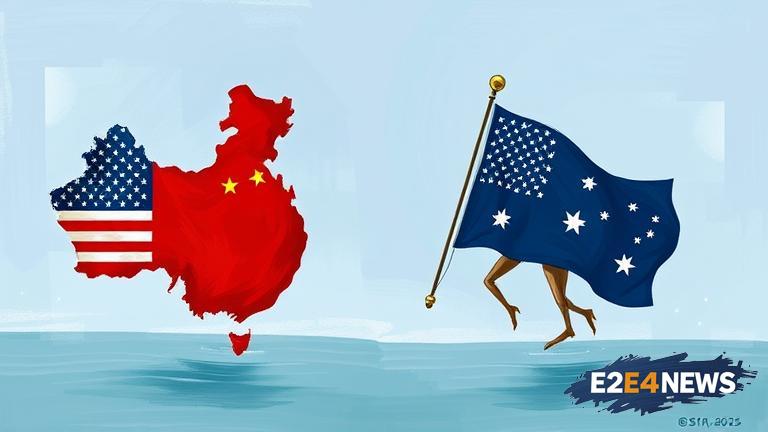Australia has been walking a fine line in its diplomatic efforts, employing a strategy known as straddle diplomacy to balance its relationships with China and the US. This approach allows the country to maintain strong economic ties with China, while also strengthening its security alliance with the US. The delicate balance is necessary due to the rising tensions between China and the US, with both nations vying for global influence. Australia’s geographic location and economic dependence on China make it vulnerable to the consequences of a potential conflict between the two superpowers. The Australian government has been working to strengthen its ties with the US, while also engaging in diplomatic efforts with China to ease tensions. The country has been a key player in the Quadrilateral Security Dialogue, a grouping of nations that includes the US, India, and Japan, aimed at promoting regional security and stability. At the same time, Australia has been seeking to expand its economic ties with China, with the two nations having signed a number of trade agreements in recent years. However, the relationship between Australia and China has been strained in recent times, with tensions rising over issues such as trade, security, and human rights. The Australian government has been critical of China’s human rights record, particularly in relation to the treatment of Uyghur Muslims in Xinjiang. China has responded by imposing trade restrictions on Australia, which has had a significant impact on the country’s economy. Despite these challenges, Australia remains committed to its straddle diplomacy approach, recognizing the importance of maintaining good relations with both China and the US. The country’s foreign minister has stated that Australia will continue to engage with China on issues such as trade and climate change, while also working to strengthen its alliance with the US. The US has been a key partner for Australia in the region, with the two nations having a long-standing security alliance. The US has also been a major investor in Australia, with many American companies having operations in the country. However, the relationship between the US and China is becoming increasingly complex, with tensions rising over issues such as trade, security, and technology. The US has been seeking to counter China’s growing influence in the region, with the Australian government supporting these efforts. At the same time, Australia has been working to promote regional stability and security, recognizing the importance of a peaceful and prosperous Asia-Pacific region. The country has been a key player in regional forums such as the Association of Southeast Asian Nations (ASEAN) and the Asia-Pacific Economic Cooperation (APEC) forum. Australia has also been working to strengthen its ties with other nations in the region, including Japan, South Korea, and India. The country’s straddle diplomacy approach has been recognized as a key factor in its ability to navigate the complex geopolitical landscape of the Asia-Pacific region. However, the approach is not without its challenges, with some critics arguing that it is unsustainable in the long term. Despite these challenges, the Australian government remains committed to its straddle diplomacy approach, recognizing the importance of maintaining good relations with both China and the US. The country’s ability to navigate the complex relationships between these two global powers will be crucial in determining its future prosperity and security. In conclusion, Australia’s straddle diplomacy approach is a unique and delicate balancing act, one that requires careful navigation of the complex relationships between China and the US. The country’s ability to maintain strong economic ties with China, while also strengthening its security alliance with the US, will be crucial in determining its future prosperity and security. As the geopolitical landscape of the Asia-Pacific region continues to evolve, Australia’s straddle diplomacy approach will remain an important factor in shaping the country’s relationships with China and the US.
